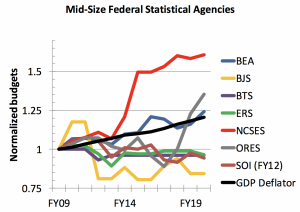Large Budget Increases for Agency Survey Mask Budget and Staff Challenges
Steve Pierson, ASA Director of Science Policy

Figure 1: The budgets of the seven mid-sized statistical agencies normalized to their FY09 levels, along with the GDP deflator to account for inflation. Budget restructuring for ERS in FY15 and ORES in FY19 are accounted for in the graph to allow for comparison. [Key: BEA, Bureau of Economic Analysis; BJS, Bureau of Justice Statistics; BTS, Bureau of Transportation Statistics; ERS, USDA Economic Research Service; NCSES, NSF National Center for Science and Engineering Statistics; ORES, Social Security Administration Office of Research, Evaluation, and Statistics; SOI, IRS Statistics of Income Division ]
I thank John Gardenier for his constructive comments on the April article about the budgets for statistical and research agencies. I was remiss to not spell out the abbreviations in this year’s article and will return to better practice next year.
Gardenier rightfully points out the lack of discussion for a major feature in Figure 1, where the normalized budgets for the mid-size principal federal statistical agencies for 2009–2020 are shown. I used that graph and Figure 2 to note a major concern: Nine of 12 federal statistical agencies (not including the US Census Bureau) had lost purchasing power since 2009, many exceeding 10 percent.
The aspect of Figure 1 I didn’t discuss is that the National Center for Science and Engineering Statistics (NCSES), which is part of the National Science Foundation (NSF), was the exception. It had gained 38 percent in purchasing power. Most, if not all, of that increase is for a single survey and masks budget and staff challenges at NCSES.
To Gardenier’s point, NCSES does have an important and unique mission in collecting, analyzing, and disseminating information about the people and establishments that drive innovation and economic growth in our country.
To shed light on NCSES’s budget over the past decade, the ASA consulted John Gawalt, NCSES director from 2013–2018, who provided several insights and issued a caution.
The following four factors generally explain the NCSES budget increase:
- NCSES’s budget is determined in part by the NSF, a science agency that inherently values data
- NSF’s budget in nominal dollars has increased 20 percent this past decade, perhaps providing it the flexibility to increase the NCSES budget
- Broad interest exists for the role STEM plays in growing our economy
- Virtually all the increases in purchasing power occurred in FY14 and FY15, and much—if not all—of it was to enhance the Survey of Doctorate Recipients (SDR)
“NCSES routinely benefits from strong NSF support because of the recognition that investments in science, engineering, and innovation play a strong role in the growth of the economy,” Gawalt wrote us. “There is a desire to better understand the drivers behind science, engineering, and innovation and how they contribute to national prosperity, especially in developing a better understanding of the cadre of scientists and engineers, their training, composition, and roles in the workforce. Building a richer, more robust information resource that captures key information about this workforce and the varied ways individuals progress through their careers is important to improving our understanding of the current contributions of these highly trained individuals and where future investments in training and education can be most beneficial.”
Gawalt also explained that the enhancement to SDR was an increase in the sample size from 47,000 to 120,000, which was “driven by a need for data to support analysis by field of degree at lower levels of aggregation.”
Gawalt further noted that the “absolute dollar increase needed to expand the SDR sample size is in line with what you would expect in terms of survey operations” but that it amounted to a large percentage increase for NCSES because of the relatively small size of its budget.
Despite the large FY14 and FY15 purchasing power increases for the SDR, Gawalt cautioned that one “should not go away with the impression that NCSES doesn’t face the budget challenges of other statistical agencies.”
“They do,” he explained, “especially in recent years because NCSES is not staffed at the level that it should be for the work that it does.” They compensate the short staffing by contracting out to external entities.
“Some of that is OK,” he commented, “as the quality of NCSES’s surveys and its capacity to conduct additional work has benefited from the contributions of its contracting activities, but buying the services of revolving contract staff is not the same as having and growing in-house expertise.”
Indeed, to Gawalt’s point on contracting, we found in a recent project that NCSES has a budget to staff ratio of $1.1 million per full-time staff member, which is more than three and a half times the median of the 13 principal federal statistical agencies—second only to the National Center for Education Statistics. Prior to the SDR expansion, this ratio was approximately $900,000 per staff member in FY12 and FY13, which makes the point that full-time federal NCSES staff did not change in line with budgets over this time period.
Like many other federal statistical agencies, NCSES has consistently been doing more over time without commensurate increases in federal staff, leaving them in need of targeted budget and staffing support in the face of increasing operational costs and other pressures.
Former Chief Statistician of the United States Katherine Wallman emphasized Gawalt’s caution, saying, “Federal statistical agencies must be responsible stewards of their taxpayer-funded budgets and sufficient internal staffing is a necessary first step in this regard.”
For more insights about NCSES, please see the recent Q&A with NCSES Director Emilda Rivers.
Returning to Gardenier’s final point regarding inter-silo communication among the various sciences, we agree and appreciate his recommendations. If you are interested in contributing brief articles about either of the following two topics, please contact Amstat News Managing Editor Megan Murphy: (i) the critical importance of statistical inclusion in collaborative scientific and engineering research and (ii) experiences in interdisciplinary endeavors.

















